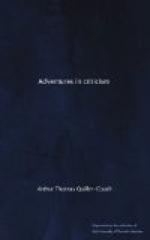The truth seems to be that the human brain abhors the complexity—the apparently aimless complexity—of nature and real life, and is for ever trying to get away from it by selecting this and ignoring that. And it contrives so well that I suppose the average man is not consciously aware twice a year of that conglomerate of details which the critics call real life. He holds one stout thread, at any rate, to guide him through the maze—the thread of self-interest.
The justification of the poet or the novelist is that he discovers a better thread. He follows up a universal where the average man follows only a particular. But in following it, he does but use those processes by which the average man arrives, or attempts to arrive, at pleasure.
EXTERNALS
Nov. 18, 1893. Story and Anecdote.
I suppose I am no more favored than most people who write stories in receiving from unknown correspondents a variety of suggestions, outlines of plots, sketches of situations, characters, and so forth. One cannot but feel grateful for all this spontaneous beneficence. The mischief is that in ninety-nine cases out of a hundred (the fraction is really much smaller) these suggestions are of no possible use.
Why should this be? Put briefly, the reason is that a story differs from an anecdote. I take the first two instances that come into my head: but they happen to be striking ones, and, as they occur in a book of Mr. Kipling’s, are safe to be well known to all my correspondents. In Mr. Kipling’s fascinating book, Life’s Handicap, On Greenhow Hill is a story; The Lang Men o’ Larut is an anecdote. On Greenhow Hill is founded on a study of the human heart, and it is upon the human heart that the tale constrains one’s interest. The Lang Men o’ Larut is just a yarn spun for the yarn’s sake: it informs us of nothing, and is closely related (if I may use some of Mr. Howells’ expressive language for the occasion) to “the lies swapped between men after the ladies have left the table.” And the reason why the story-teller, when (as will happen at times) his invention runs dry, can take no comfort in the generous outpourings of his unknown friends, is just this—that the plots are merely plots, and the anecdotes merely anecdotes, and the difference between these and a story that shall reveal something concerning men and women is just the difference between bad and good art.
Let us go a step further. At first sight it seems a superfluous contention that a novelist’s rank depends upon what he can see and what he can tell us of the human heart. But, as a matter of fact, you will find that four-fifths at least of contemporary criticism is devoted to matters quite different—to what I will call Externals, or the Accidents of Story-telling: and that, as a consequence, our novelists are spending a quite unreasonable proportion of their labor upon Externals. I wrote “as a consequence” hastily, because it is always easier to blame the critics. If the truth were known, I dare say the novelists began it with their talk about “documents,” “the scientific method,” “observation and experiment,” and the like.




